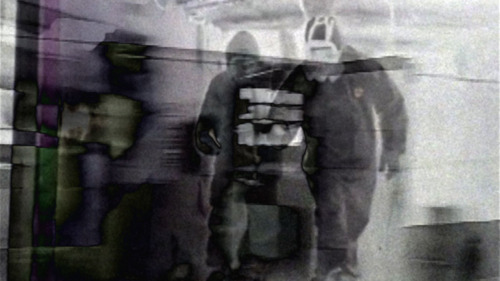
Amusement Park of Glowing Dreams
Filmmaker and Directors Lounge fixture Klaus W. Eisenlohr took the gathering on hand at Z-Bar’s screening space (22.03.12) on a rollercoaster ride to and through the Atomic Age’s forbidden zones with his curated program “Pripyat – The Uncanny of Modernity”. Not only Pripyat, Chernobyl’s ghost-ridden neighbouring city, but also other nuclear oddities were shown in light of a global fascination whose half-life is not yet known. This aesthetic preoccupation and its uneasy place in the nuclear discussion were at the heart of the selection, rather than any purely documentary vehicles or didactic essays. Several films in the 90-minute set were little more (but nothing less) than hazy imagery, as in the opener, Anders Weberg’s Peaceful Atom (SE), a multi-planed soup of impressionistic smears revealing forms and sounds. Nicky Larkin’s Pripyat (IE) followed, with static shots accompanied by howling winds and the incessant buzzing of flies. The deserted city emerges as a modern-day Angkor Wat, with radiation as the unseen jungle. Black figures painted on walls hark back to Pompeii’s ashen corpses, victims of a similarly sudden fate. Finally, Lenin’s face emerges, as lifeless and frozen in time as the scene he presides over. Immaterial Meshup (Sarah Breen Lovett, AU) opens on a television and takes us swiftly to futuristic cityscapes of Metropolis and Blade Runner, uniformly black and white and swathed in aphorisms. Other standouts included Gair Dunlop’s Atom Town: Life After Technology (UK), running newsreel propaganda footage on the Dounreay facility in split screen next to mostly colour updates of the same scenes, silent sentries to a then unknown future (its sentimentally greeted disengagement), wordlessly speaking louder than the narrator’s voice from the screen’s other half. Vanessa Renwick’s Portrait #2: Trojan (US) puts an atomic silo before intensified sunset views resembling Group of Seven stylization, then lets us witness the controlled demolition of the ominous tower. Eisenlohr’s own Phantasma Pripyat (DE) wove cascading found footage between flutter-by landscapes and computer games into a look at Elena Filatova’s counterfeit motorcycle tour in the forbidden zone around Chernobyl. Ribbon text website comments chase snippets of facts and each other so that the viewer is swimming in a sea of truths, half-truths and outright lies or flights of fancy that well represent the muddle of (mis)information that characterized the event. A discussion followed the films, with varying views on the attraction to voyeurism and its legitimacy. Eisenlohr’s Urban Research presentations run with monthly regularity, offering windows to the grand scheme of things cosmopolitan. In addition, they provide thematic pillars in the annual Berlin International Directors Lounge, back for its ninth incarnation in February 2013. Kenton Turk
pictured: Phantasma Pripyat by Klaus W.Eisenlohr
